Azure VPN Gateway
Overview
Azure VPN Gateway is a key component of Microsoft Azure's networking services, providing secure and scalable connectivity between on-premises networks, remote users, and Azure resources. It facilitates the establishment of Virtual Private Network (VPN) connections, enabling organizations to extend their on-premises networks to the Azure cloud securely.
At its core, Azure VPN Gateway serves as a bridge between on-premises data centers or user devices and Azure Virtual Networks. It employs industry-standard protocols, such as Internet Protocol Security (IPsec) and Secure Socket Tunneling Protocol (SSTP), to establish encrypted connections, ensuring the confidentiality and integrity of data transmitted over the network.
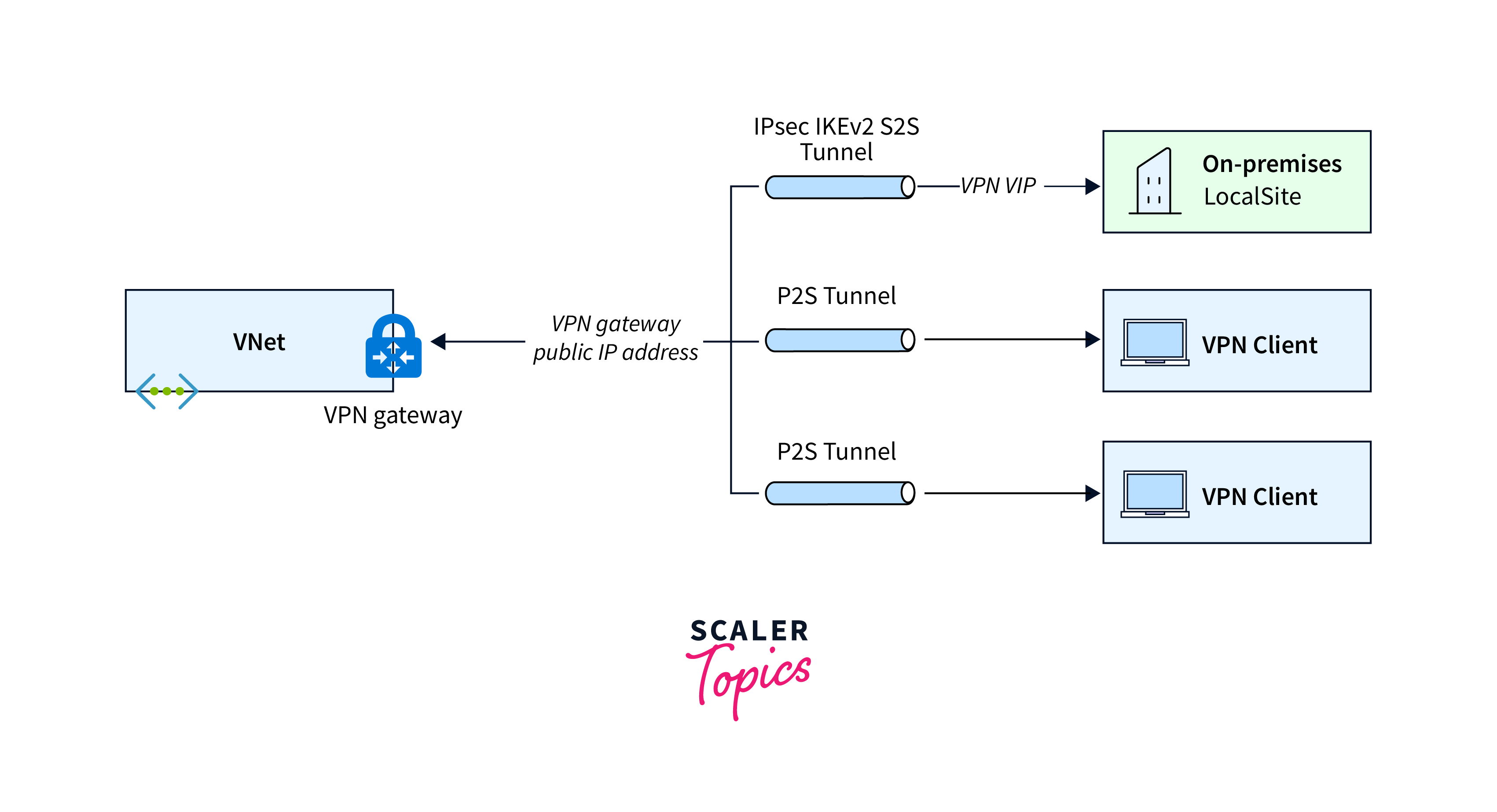
Key Features of Azure VPN Gateway
Let's delve into more detail about some of the key features:
-
Site-to-Site Connectivity: Azure VPN Gateway facilitates the establishment of secure site-to-site connections, allowing seamless integration between on-premises networks and Azure Virtual Networks.
-
Point-to-Site Connectivity: For remote or mobile users requiring secure access to Azure resources, Azure VPN Gateway supports point-to-site connectivity.
-
ExpressRoute Integration: Azure VPN Gateway seamlessly integrates with Azure ExpressRoute, providing organizations with the option to establish dedicated and private connections to Azure.
-
Scalability: Acknowledging the varied performance needs of organizations, Azure VPN Gateway is engineered for dynamic scalability. This ensures that as demands evolve, the VPN Gateway can seamlessly expand its capacity to handle increased workloads and growing network requirements.
-
Redundancy: For uninterrupted and dependable connectivity, Azure VPN Gateway supports both active-active and active-passive configurations. This redundancy feature enhances reliability by providing failover options. In active-active mode, traffic is distributed across multiple gateways, optimizing resource utilization. In active-passive mode, one gateway serves as the primary while the other remains on standby, ready to take over in case of a primary gateway failure. These configurations bolster the resilience of the VPN Gateway, contributing to continuous and robust network operations.
-
Multi-Protocol Support: Azure VPN Gateway provides flexibility with support for various VPN protocols, including industry standards like IKEv1, IKEv2, and OpenVPN. This versatility allows organizations to choose the most suitable protocol for their specific requirements, ensuring seamless integration with diverse network environments and accommodating a range of devices and configurations.
-
Security Features: Security is a paramount concern, and Azure VPN Gateway addresses this with robust encryption and authentication mechanisms. These features work together to ensure the confidentiality and integrity of data transmitted over the VPN connections.
-
Multi-Region Deployment: Azure VPN Gateway accommodates the global nature of businesses by supporting deployment across multiple Azure regions. This capability enables organizations to establish secure and resilient network connections, strategically position resources for improved performance, and create geo-redundant architectures for enhanced reliability during disruptions.
Planning Table

Gateways SKUs

Encryption Algorithms
-
Encryption Algorithms:
- Azure VPN Gateway supports AES (128, 192, 256 bits) for data encryption.
-
Authentication:
- HMAC-SHA is used for authentication in both Phase 1 and Phase 2.
-
Diffie-Hellman Groups:
- Azure supports various Diffie-Hellman groups, including Group 2, 14, 24, 5, and 19.
-
Perfect Forward Secrecy (PFS):
- PFS is implemented to ensure ongoing security, even if private keys are compromised.
-
Configurability:
- Administrators can configure settings via Azure Portal, PowerShell, or ARM templates.
-
Rekeying:
- Automatic rekeying occurs based on configurable lifetimes to maintain security.
-
VPN Gateway SKUs:
- Different SKUs offer varied encryption levels and throughput options.
-
Security Best Practices:
- Choose configurations based on specific security requirements and stay updated on Azure service changes.
VPN Types in Azure
Azure provides various VPN types to accommodate different connectivity requirements. Here are five VPN types available in Azure:
-
Point-to-Site (P2S) VPN:
- Use Case: Point-to-Site VPN is designed for remote or mobile users who need secure access to Azure resources.
- Description: This VPN type allows individual devices to connect to an Azure Virtual Network over a secure VPN connection.
-
Site-to-Site (S2S) VPN:
- Use Case: Site-to-Site VPN is used to establish secure connections between on-premises networks and Azure Virtual Networks.
- Description: Site-to-Site VPN extends the corporate network into the Azure cloud, enabling seamless communication between on-premises infrastructure and Azure resources.
-
ExpressRoute:
- Use Case: ExpressRoute is suitable for organizations requiring dedicated, private network connections to Azure.
- Description: Unlike traditional VPN connections over the public internet, ExpressRoute provides a dedicated, private connection to Azure.
-
VNet-to-VNet VPN:
- Use Case: VNet-to-VNet VPN is employed when connecting multiple Azure Virtual Networks.
- Description: This VPN type allows secure communication between different Azure Virtual Networks. It is useful in scenarios where an organization has distributed workloads across multiple Azure regions or needs to create a hub-and-spoke network topology.
-
Multi-Site VPN:
- Use Case: Multi-Site VPN is beneficial for organizations with multiple branch offices that need to connect to Azure.
- Description: Multi-Site VPN allows connections from multiple on-premises sites to an Azure Virtual Network.
Setting Up Azure VPN Gateway
Here's a general guide to setting up an Azure VPN Gateway:
Step 1: Azure Portal Access
- Log in to the Azure portal.
Step 2: Create a Virtual Network
- In the Azure portal, navigate to "Create a resource," then select "Networking" and choose "Virtual Network."
- Follow the wizard to create a new VNet. Define the address space, subnets, and other relevant settings.
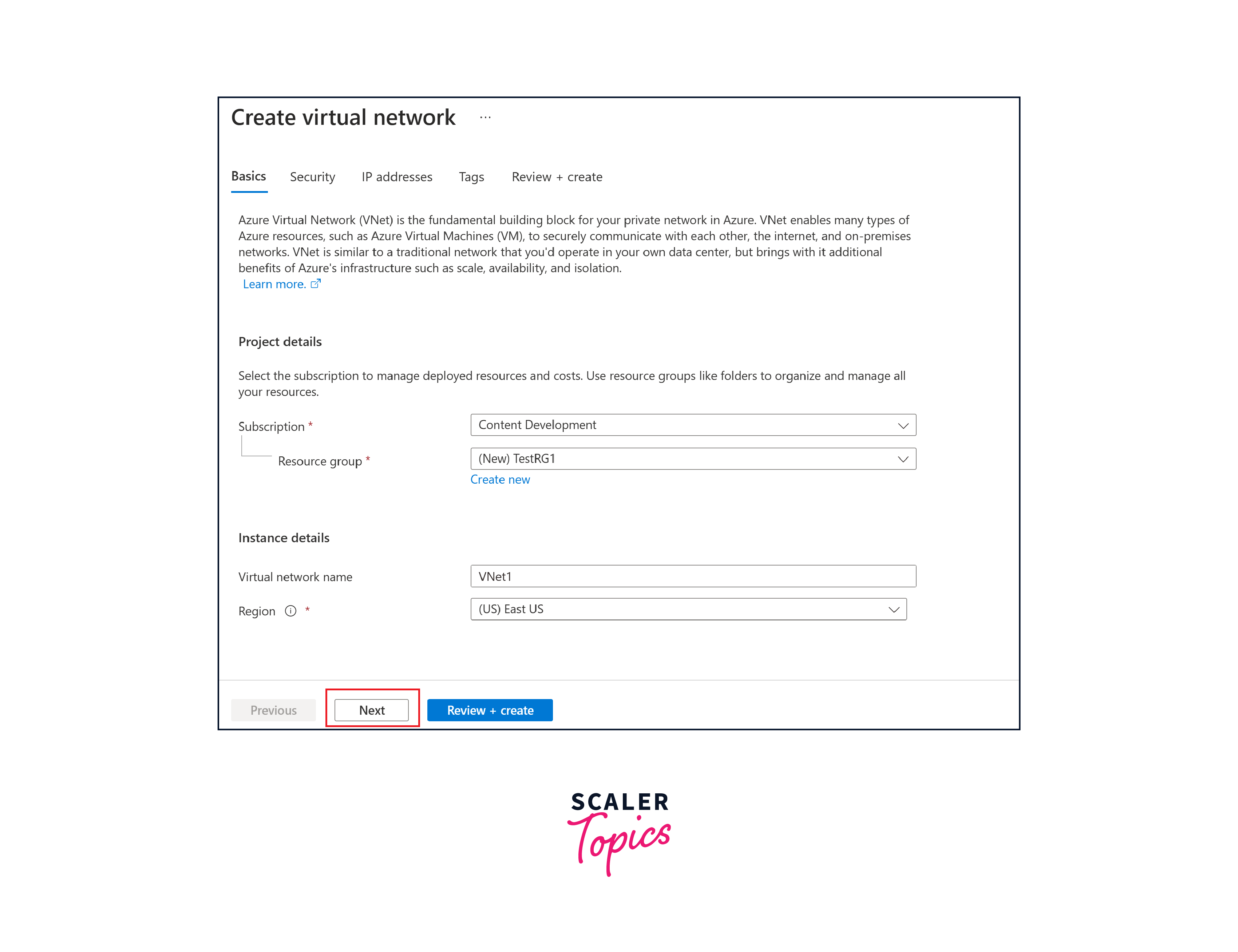
Step 3: Create a Gateway Subnet
- Within the VNet configuration, create a subnet specifically for the VPN Gateway. This subnet will host the Azure VPN Gateway.
Step 4: Create a VPN Gateway
- In the Azure portal, navigate to the "Create a resource" section, select "Networking," and choose "VPN Gateway."
- Complete the configuration wizard, specifying the gateway type, VPN type (Route-based or Policy-based), SKU, and other settings. The SKU determines the performance and features of the VPN Gateway.
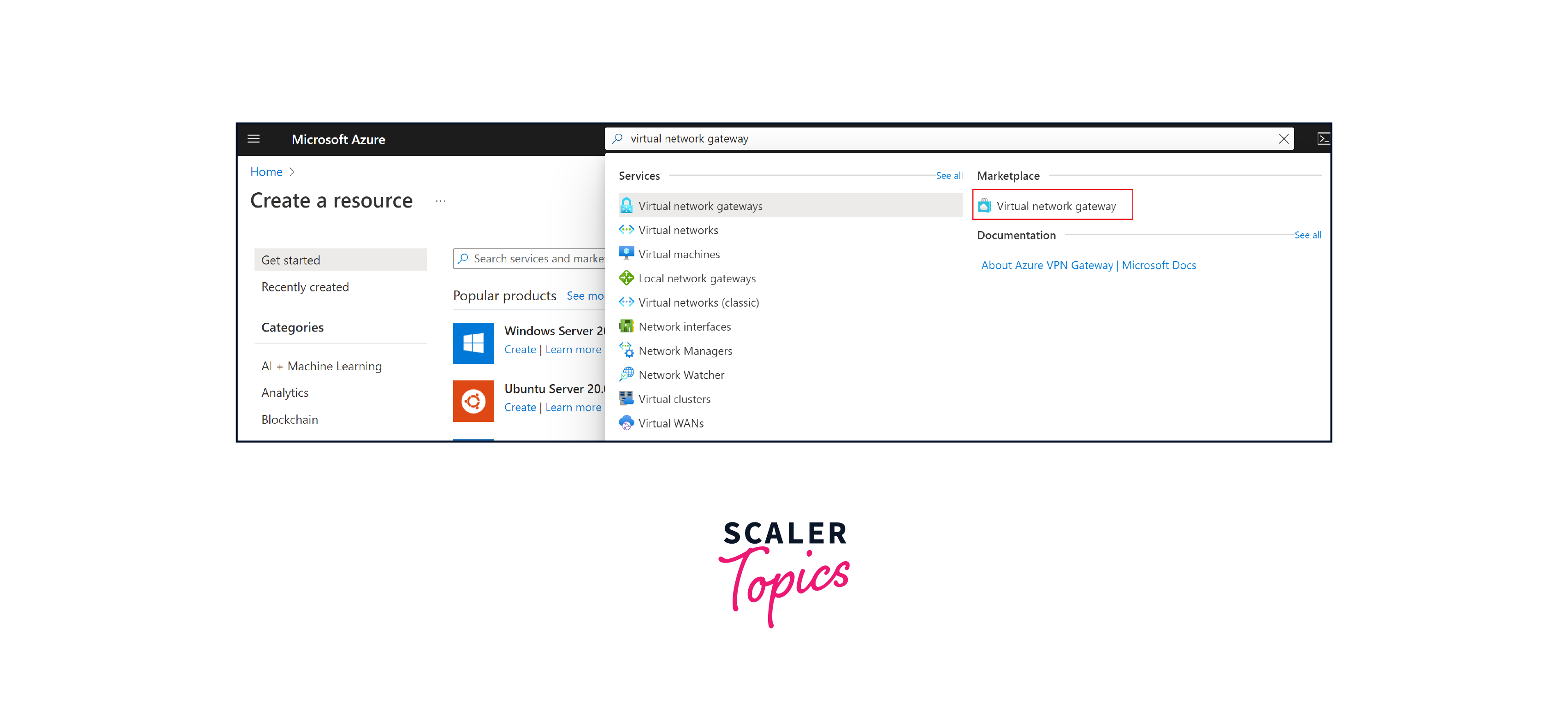
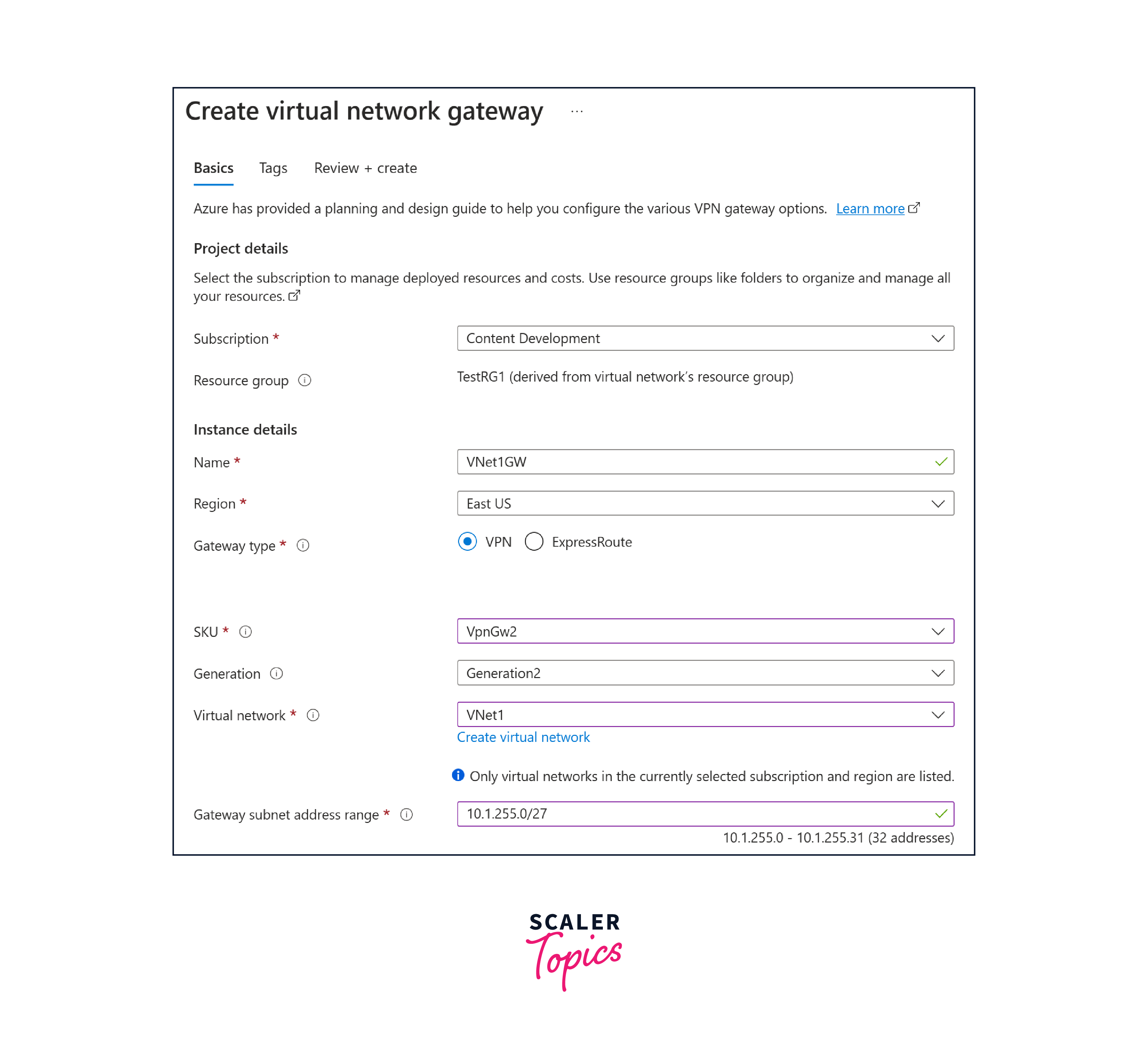
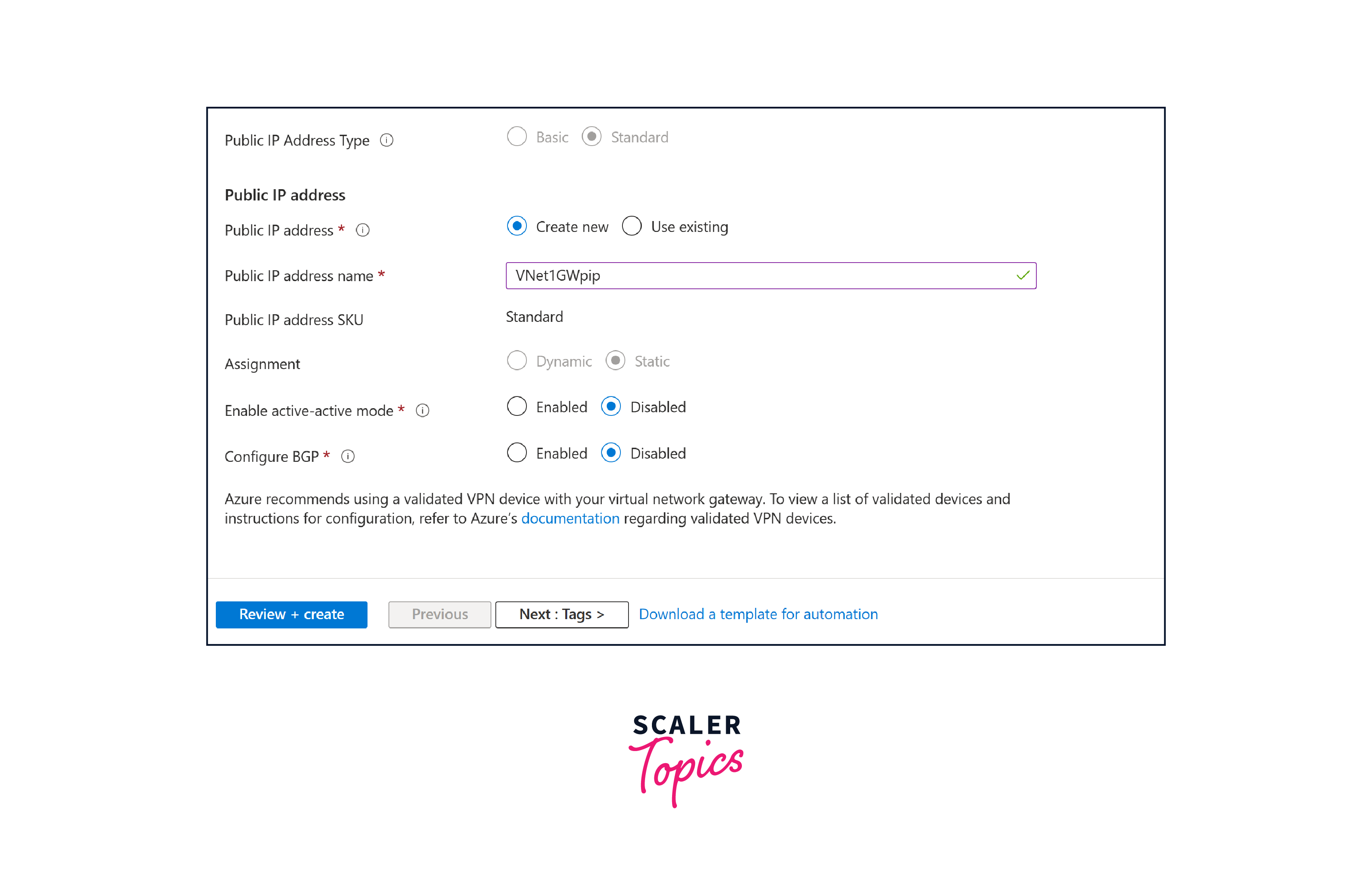
Step 5: Configure Connection
- After the VPN Gateway is created, navigate to its settings, select "Connections," and click "Add Connection."
- Define the connection settings, including the connection type (Site-to-Site, Point-to-Site, etc.), local and remote site details, and authentication method.
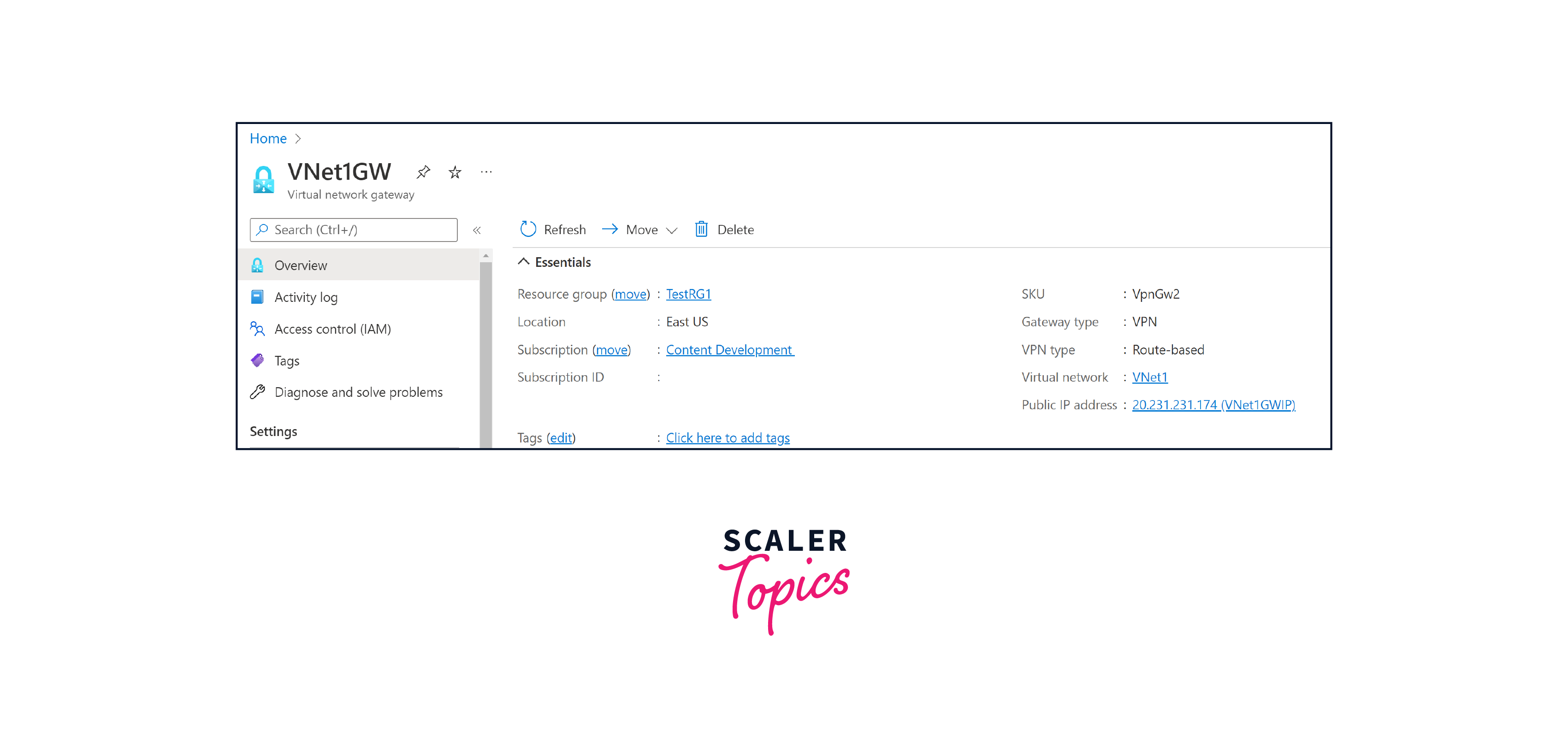
Step 6: Configure Local Network Gateway
- If you are setting up a Site-to-Site VPN, create a Local Network Gateway object. This represents the on-premises VPN device, and you'll define its public IP address and address space.
Step 7: Configure VPN Device
- On the on-premises VPN device, configure the settings based on the VPN type and connection details provided in Azure. This includes IPsec/IKE parameters, pre-shared keys, and routing.
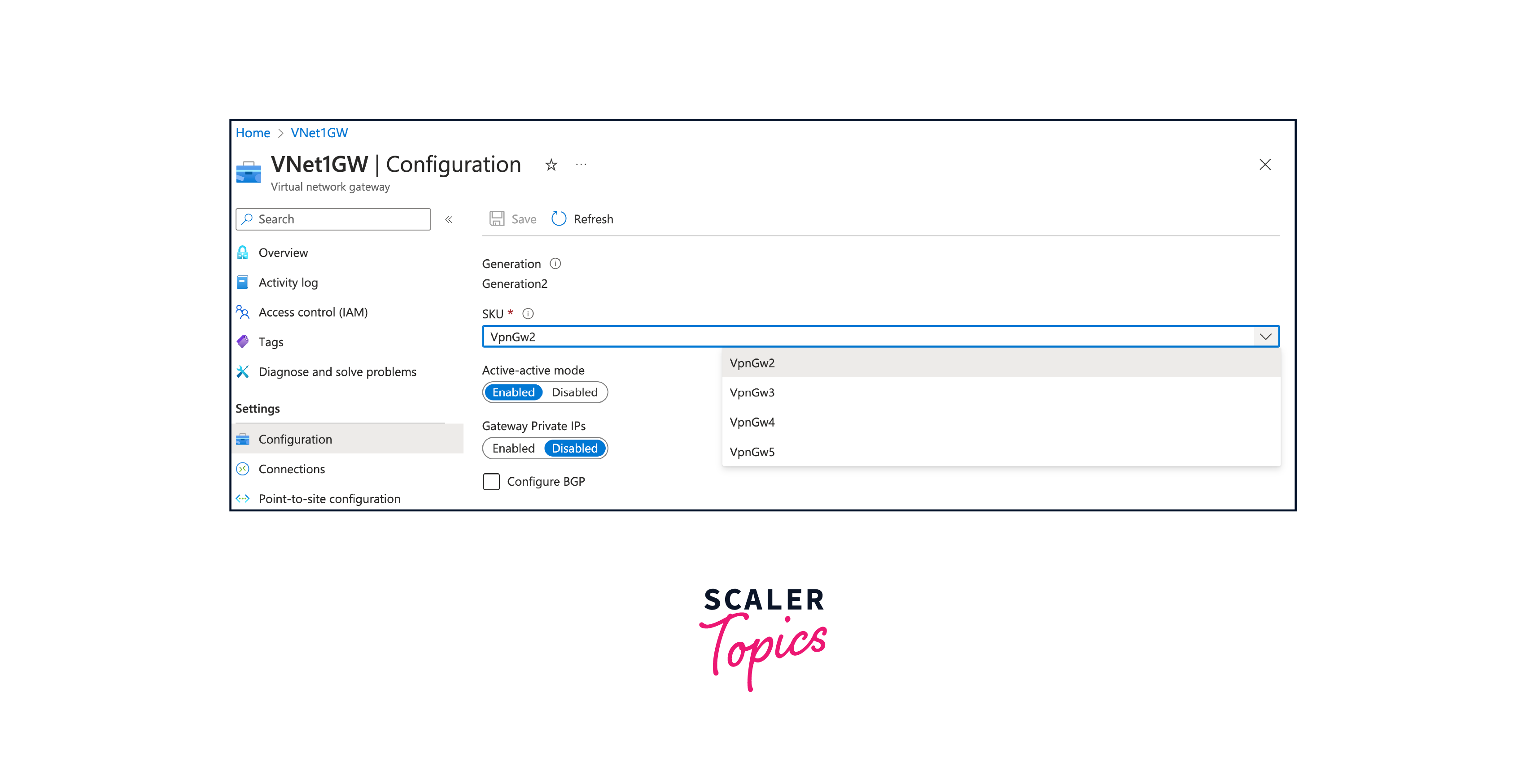
Step 8: Connection Validation
- Once everything is configured, Azure will attempt to establish the VPN connection. Monitor the connection status in the Azure portal.
Step 9: Testing and Troubleshooting
- Verify connectivity between on-premises and Azure resources. Utilize Azure Monitor and diagnostics tools for troubleshooting, if needed.
Step 10: Monitoring and Maintenance
- Regularly monitor the VPN Gateway's performance using Azure Monitor. Consider scaling the VPN Gateway based on changing requirements.
Key Exchange Protocols:
-
IKE (Internet Key Exchange):
- Establishes secure channels for subsequent negotiations.
- Versions include IKEv1 and IKEv2.
-
Diffie-Hellman (DH):
- Used for secure key exchange.
- Various groups supported, such as Group 2, 14, 24, 5, and 19.
-
Perfect Forward Secrecy (PFS):
- Ensures even if private keys are compromised, past session keys remain secure.
Security Measures in Azure VPN Gateway
-
Encryption Algorithms:
- Utilizes AES (128, 192, 256 bits) for secure data transmission.
-
Authentication:
- HMAC-SHA for message integrity and authentication.
-
Security Associations (SA):
- Establishes and manages secure connections between peers.
-
Key Management:
- Automated keying and rekeying processes for ongoing security.
-
Policies and Configurations:
- Administrators configure security policies through Azure Portal, PowerShell, or ARM templates.
-
Multi-Protocol Support:
- Supports both IKEv1 and IKEv2 protocols for flexibility.
-
VPN Gateway SKUs:
- Different SKUs (Basic, Standard, High-Performance) offer varying security capabilities.
Pricing and Availabilty
Here are some key points related to pricing and availability:
Pricing:
Azure VPN Gateway pricing typically includes considerations for the following factors:
-
Gateway SKU: Different SKUs (Basic, VpnGw1, VpnGw2, VpnGw3) offer varying performance levels, and each has its associated cost.
-
Data Transfer: Outbound data transfer from the Azure VPN Gateway to on-premises and other regions may incur additional costs.
-
Connection Hours: Costs may be based on the duration of active VPN connections.
-
ExpressRoute Integration: If you integrate Azure VPN Gateway with Azure ExpressRoute, there might be separate costs associated with ExpressRoute.
-
Geo-Redundancy: If you deploy VPN Gateways in multiple Azure regions for geo-redundancy, there could be additional costs.
Availability:
Azure VPN Gateway is available globally across multiple Azure regions. However, specific features and capabilities may vary by region. You can check the Azure products by region page to see the availability of Azure VPN Gateway in different regions.
When planning your deployment, consider choosing a region that aligns with your geographical requirements and provides the necessary features and performance.
To get the most up-to-date information on Azure VPN Gateway pricing and availability, please refer to the official Azure documentation and pricing pages mentioned above or visit the Azure portal.
Limitations
Here are some common limitations and considerations associated with Azure VPN Gateway:
-
Throughput Limitations:
- The performance of Azure VPN Gateway is tiered into different SKUs (Basic, VpnGw1, VpnGw2, VpnGw3), each with its associated maximum throughput. It's important to choose a SKU that meets your performance requirements.
-
Policies and Configuration Limitations:
- While Azure VPN Gateway supports both route-based and policy-based VPNs, there might be limitations on the specific policies or configurations based on the chosen SKU.
-
Active Tunnels:
- Each VPN Gateway SKU has a maximum limit on the number of active tunnels it can support. Be aware of these limits and choose a SKU that aligns with your connectivity needs.
-
Supported VPN Protocols:
- Azure VPN Gateway supports various VPN protocols, including IKEv1, IKEv2, and OpenVPN. However, there might be limitations or considerations regarding compatibility with certain on-premises VPN devices.
-
Point-to-Site VPN Considerations:
- For Point-to-Site VPNs, there are limitations on the number of concurrent connections and the type of authentication methods supported.
-
ExpressRoute Integration:
- While Azure VPN Gateway can integrate with Azure ExpressRoute for a hybrid network architecture, there might be considerations regarding the compatibility of ExpressRoute configurations with VPN Gateway.
Conclusion
- Azure VPN Gateway provides a secure and encrypted connection, facilitating communication between on-premises networks, remote users, and Azure Virtual Networks.
- Supports various VPN types, including Point-to-Site, Site-to-Site, ExpressRoute, VNet-to-VNet, and Multi-Site VPNs, catering to diverse connectivity requirements.
- Offers different SKUs with varying performance levels, allowing organizations to choose a gateway that aligns with their throughput requirements and scale dynamically.
- Supports active-active and active-passive configurations for high availability, minimizing downtime and ensuring continuous connectivity.
- Seamlessly integrates with Azure services like Azure ExpressRoute, Azure Monitor, and Azure Application Gateway, enhancing overall network capabilities.
